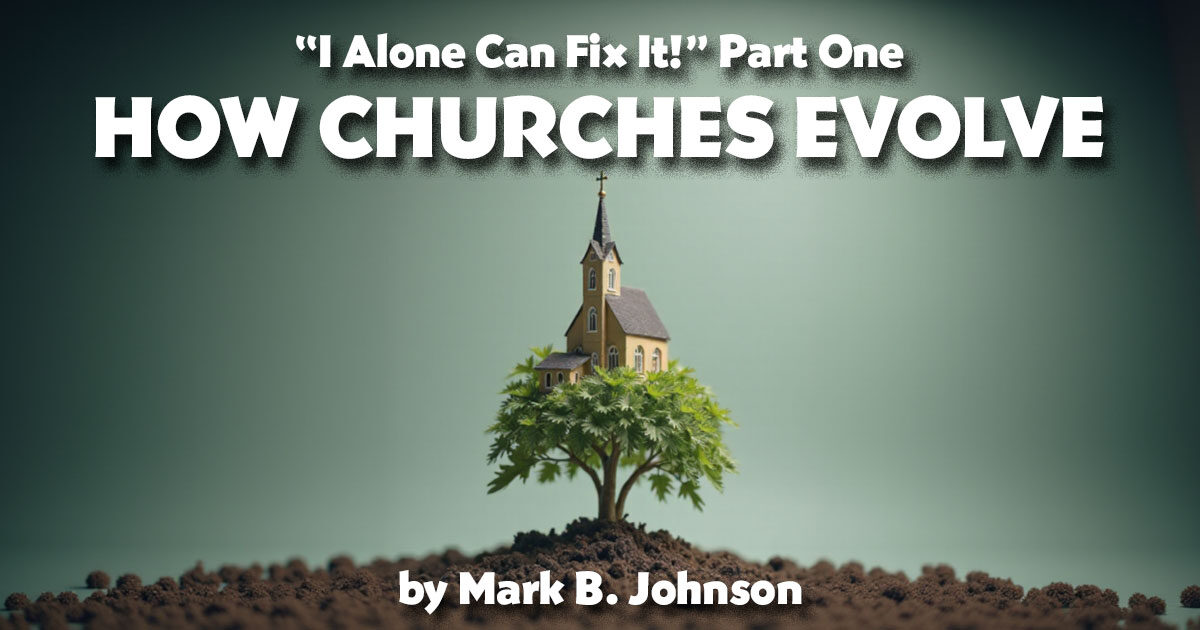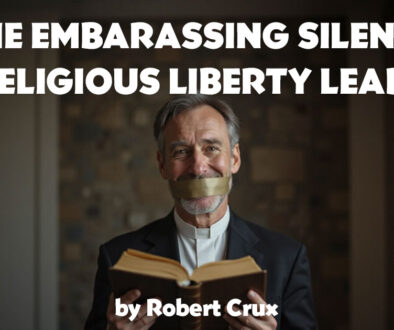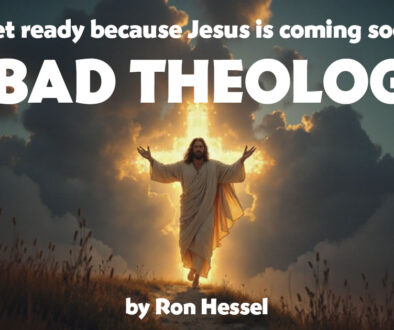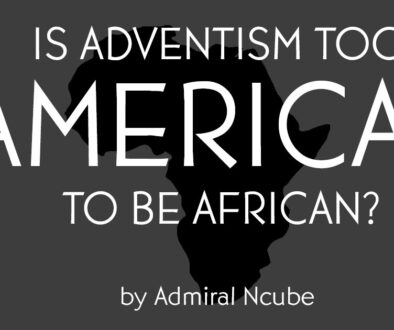“I Alone Can Fix It”: How Churches Grow and Evolve
by Mark Johnson | 17 June 2025 |
Adventism is in a decades-long crisis. We are split into at least two different churches.2 Reinder Bruinsma and others have defined the widely differing categories into which we fall. New members pour into the church in some geographical areas while the disenchanted hemorrhage out the back door in others. Groups as dissimilar as Adventist Today and Fulcrum 7 claim they represent true Adventism. There is great general unrest among those members in Western Europe and America who remain.
My home church was recently threatened with disbarment by the local conference. It was implied by some on its Executive Committee that I, personally, should be disfellowshipped.
Indeed, almost weekly I am asked why I’m still an Adventist. I’ll tell you why.
Because I alone can fix it.1 And it’s because I’m a lay person.
Church development
Ernst Troeltsch3 and H. Richard Niebuhr4 both described the natural history of religious movements. Churches generally start with an enthusiastic sect—but can sometimes end in disillusionment and disintegration.
Members of a sect tend to be young adults, mission driven, and very evangelical. They are frequently monocultural: of similar age, social standing, and geographic locale. They join the sect sometimes at great societal and familial cost: most members of the sect are either of the first or second generation in their family to have joined. Participation is a very personal thing. There is little, if any, formal structure or organization. Everyone is on equal footing.
Growth can be rapid. They think they will single-handedly evangelize and save the world. They are insiders focused on spiritual truth, which they alone have. The rest of the world are outsiders. Those not yet reached live in what Adventists used to call “dark counties.” They see solutions to problems as coming from outside of this world. They are suspicious of or antagonistic toward formal religions and governmental powers.
Niebuhr called the next step denominationalism: a transitional stage between sects and what Troeltsch called churches. They tend to be middle-aged, both as organizations and as members. They are formally organized and may be bureaucratic and hierarchical. Unlike sects, they are multicultural, pluralistic, and are somewhat more tolerant. They typically are more progressive in their social and political stances than are churches. Their organizations are often well-oiled machines—but they may have lost their mission and their distinctive identity.
They have evolved from sects, but are now more mainstream and less radical. They have more social acceptance and respectability. They have learned that they are not the only “good people”. They see themselves as being one group among many through whom God is working. They often must work to remember what the real difference is between their movement and other denominations or churches.
Structural power
Troeltsch identified the most mature level as the church stage of religious development. Now, the organization and its leading members are older. Most members were born into the church. Infant baptism may be the means of becoming a member. There could be societal benefits and economic rewards to membership—all the best people in the business community go to church there.
There is a highly organized hierarchical structure of power: a well-defined level of ecclesiastic, priestly leadership, with a wide separation between them and the laity. Leadership defines doctrines, establishes a creed, and generally runs the church. Lay members are expected to obey, conform, and support. Solutions to problems are to be found here on earth. Leaders feel they can usually handle these problems. Occasionally they may need to access, or even appropriate, governmental resources and power to help. Membership is frequently multigenerational. Growth is stagnant or decreasing.
Troeltsch added an additional social form of religion which he called mysticism. He saw a mystic not as one who has miraculous visions or supernatural experiences but one who is subjectively spiritual but not linked to any religious organization. They have a very personal and internal form of religion. They are more experiential than biblical. They view membership in a church or sect as being unimportant, or even detrimental. The free individual experience is what matters.
As Troeltsch was studying contemporary American religious culture in the early 20th century, this was the fastest-growing type of religion. It continues to be today. Folks in this group are currently designated as the “nones.” They have no religious affiliation. They may self-identify as atheist, agnostic, or “nothing in particular.” They find too many flaws in organized religion to join, remain, or get involved.
Non-linearity
The linearity of this traditional church sect-theory has been challenged more recently by Landon Schnabel5 and his colleagues. Their studies find a circular faith-religion framework related in large part to “young adults navigat(ing) tensions between institutional religion and personal authenticity.” Instead of an ineluctable march toward institutionalization, they picture a tension: a pendulum swinging “between individualized spirituality and institutional religion.”
This view more accurately addresses both the mysticism of the individual “nones” religion that Troeltsch noted, and the common drive we often see in some churches by members who seek to recover the “preinstitutional” zeal of their historical movement.
Adventism
The Adventist Church today exhibits characteristics of all of these religious stages. There are whole geographical areas around the world that resemble sects. There are offshoots that are clearly cults. Likewise, there are regions that look more denominational. And there are a few regions that are quite churchy. There are also many members, or ex-members, who actively or passively identify themselves as belonging to none of the above.
Overall, as an organization, however, I think we have followed the defined trajectory from zealous sect to well-structured denomination. For the most part, I believe we are not large enough or socially acceptable enough to be classified as a formalized church. We do, however, have many members moving into the “none” category.
Our natural history as a religious movement has not been unique. We are much like the others. We were not supposed to be. We were to be wholistic.
I say again: I alone—a lay person—can fix it. Though I can’t do it alone. I need the rest of you to help me.
Next: What should make Adventism different?
1 The title is taken from a quote by Donald J. Trump at the 2016 Republican National Convention. Much of the essay, however, reflects the thought of Dr. Jack Provonsha, from a seminar titled “Adventist Church in Crisis,” recorded in Portland, Oregon, in September 1981.
2 Johnsson, William G. Where Are We Headed? Adventism after San Antonio. (Oak and Acorn Publishing: Westlake Village, CA, 2017)
3 Troeltsch, Ernst. Protestantism and Progress. (Transaction Publishers, 2013)
4 Niebuhr, H. Richard. The Social Sources of Denominationalism. (Meridian Books, 1957)
5 Schnabel, Landon, et al. “Breaking Free of the Iron Cage: The Individualization of American Religion.” 2025, 11: 1-27. Socius
 Mark B. Johnson is a graduate of Pacific Union College and Loma Linda University, with a medical residency at Johns Hopkins University in Preventive Medicine and Public Health. He is a retired local public health officer from the Denver metropolitan region. He’s an adult Sabbath School class teacher and church board vice-chair at the Boulder Adventist church.
Mark B. Johnson is a graduate of Pacific Union College and Loma Linda University, with a medical residency at Johns Hopkins University in Preventive Medicine and Public Health. He is a retired local public health officer from the Denver metropolitan region. He’s an adult Sabbath School class teacher and church board vice-chair at the Boulder Adventist church.




